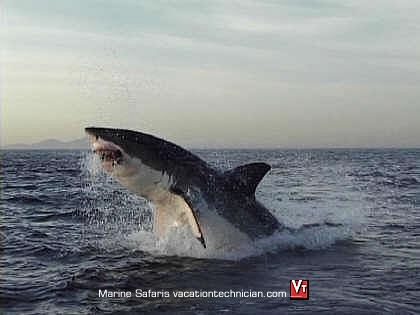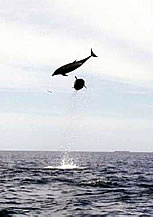![]()
Great White Shark Diving?!

Vacationtechnician personalized luxury adventure travel transports you to the most exquisite wilderness and chill out retreats on Earth. Conserving rare biodiversity through low volume tourism; our aim is your indulgence -at no one's expense. Plan now to be assured a rejuvenating escape at a restful pace -to an unspoilt gem in the purest sense.
About 64 000 Cape fur seals crowd on to Seal Island, in False Bay at the south-western tip of Africa. They share the tiny island with up to a hundred African penguins and with Cape and white-breasted cormorants and the occasional sub-Antarctic skua. In the waters and reefs around are sponges and soft corals, fish such as red roman and hottentot, and yellowtail in the warmer months - and the great white shark, whose predatory behaviour here is distinctive and highly successful.
A light north-westerly breeze gently ripples the water's surface off Seal Island, turning it into a multitude of pretty mosaics. Just south of the island a young Cape fur seal is returning to the island from a feeding expedition. Most adult seals depart and return in groups, knowing instinctively that there is safety in numbers - there are many more eyes to watch out for lurking predators, while amongst a multitude of twisting shapes it is difficult for a hunting great white shark to single out an individual. This lone, inexperienced seal, indiscernible to the untrained eye, is about to face what we call 'the ring of peril'.
Twenty metres down, the great fish turns. As it tracks along the rocky seabed it catches sight of the seal's tiny silhouette. With two great sweeps of its tail, the one-ton great white shark propels itself towards the surface. The seal, on one of its slow rolls, is suddenly aware of the approaching black-and-white missile. Instinctively it fears the shark more than any other predator in the sea. It turns tightly, but too slow. The shark blasts itself and its prey metres into the air, the seal balanced on the grasping teeth of the huge fish's lower jaw. Hundreds of litres of spray cascade down to the surface and, in an explosion of ocean, the two simultaneously strike the sea. The seal is injured but still alive.
The chase is on - and now we witness an amazing feat of self-preservation. Instead of fleeing, the seal, steering clear of the shark's razor-sharp teeth, turns and tucks in close to the fish's rapidly moving tail. The shark swipes ineffectually several times with its tail, but knows that the energy expended will not equal the return from such a small quarry. It banks deeply, returning to its stalking grounds where it blends perfectly with its surroundings once more.
The seal rapidly porpoises the last 150 metres before making its final dive for the island. A crimson trail of highly oxygenated blood marks its path up the beach, testimony to its encounter with the ocean's most formidable predator.
Seal Island, described by top shark scientists as the last great untouched predator/prey hunting ground, lies five kilometres from the mainland and is about 450 metres long, give or take a few metres depending on the tide. The eastern shore is characterised by a gently sloping shoal, but to the west and south the water depth drops quickly to 25 metres. It is here that the great whites lie in wait, using the deeper water to achieve maximum camouflage - and to gain speed as they power their way upward to attack a seal. Their assault culminates in a visually spectacular burst of flight, known as 'predatory breaching'.
Often these huge sharks launch themselves skywards towards any shape that resembles their natural food source. In a research project that we undertook in 1999 we used two cut-outs, one in the shape of a square and one in the shape of a seal. When the targets were stationary there was unquestionably a clear preference for the seal; however, when both were moving, the sharks showed little discrimination, provided that the shapes fell within a certain size range.
Other research projects have included colour-coded tagging, in which individual animals were identified. Thus we learned that sharks have unique and clearly defined personalities. One, dubbed Black-white-black, was a very confident and highly successful hunter, seen to make three kills in a week; another, known as Rasta, was so slow and laid-back that we wondered how she ever caught a seal.
Seal Island is the world's premier natural feeding ground for the great white. Its success rate here is phenomenal: about 45 per cent of attacks culminate in kills, a ratio that, among large predators, is very high. Remarkably, it can go even higher; certain individuals, more determined than others, may achieve up to 80 per cent success.
Nevertheless, the seals are highly resilient to these attacks and have their own defences, such as sharp teeth and claws with which they can inflict serious damage to a shark's snout and eyes. Often, even in mid-breach and while firmly clamped between the jaws of the shark, these never-say-die seals try to bite their powerful adversaries. They are also highly aware of the presence of sharks, their state of tension or relaxation always the first indicator of the abundance of sharks around the island. When the sharks are absent, it is a pleasure to watch large groups of them cavorting with gay abandon many metres offshore.
For centuries the great white shark has captured the interest of all those fascinated by the ocean. Having been privileged to work with this magnificent predator for many years, we can but try to convey the need to protect it from the ignorance still prevalent today. It is not a scourge, but rather a great asset to any country fortunate enough to have it occurring along its shores. In South Africa we must do everything possible to conserve the population we have and provide a safe refuge for this lonely lord of the seas.
About the great white shark
EVOLUTION
Carcharodon carcharias (literally, 'ragged tooth shark') is believed to be
descended from Cretolamna appendiculata which existed about 65 to 95 million
years ago.
SIZE
The largest recorded great white, captured off Cuba, was 6.4 metres long.
The largest measured in South Africa, caught off Gansbaai in 1987, was 5.9
metres long. The largest that we've seen we conservatively estimated at 6
metres in length and well over 2 500 kilograms in mass.
LONGEVITY
Experts estimate that great white sharks live for between 30 and 40 years.
REPRODUCTION
Females reach maturity at between 12 and 15 years (4.3 to 4.5 metres long);
males mature at 9 or 10 years (3.8 to 4 metres). The average number of pups
born appears to be between 7 and 9. The young are born free-swimming and are
1.2 to 1.5 metres long at birth.
DIET
Great whites appear to be fairly selective in what they consume but are prepared
to 'taste test' a range of items, including seaweed, cardboard boxes and decoys.
In our area the abundance of great whites was dictated largely by the movement
of summer fish species such as yellowtail, and in the warmer months the sharks
show a preference for these fish over seals (which they can catch at any time).
DENTITION
Small great whites have narrow teeth more suited to grasping fish; as the
sharks mature, the teeth become broader and thus are more suited to coping
with large mammal prey. The large teeth are arranged in five rows. The top
jaw has typically 26 teeth (13 on either side) while the bottom jaw has 24
(12 on either side).
Diving South Africa:
- Has become famous for shark diving: there is both shark cage diving in the
Western Cape as well as free diving amongst the sharks in during KwaZulu Natal's
annual Sardine Run.
- Coral reefs and a multitude of shipwrecks provide fascinating underwater
viewing
- Whales, seals, endangered sea turtles, birds like Jackass Penguins and African
Oystercatchers
- Thousands of different fish species
- Stunning, pristine beaches
Mozambique:
- Offers beautiful, subtropical islands in the Bazaruto Archipelago
- Tropical fish, endangered sea turtles and Dugongs
- Breathtaking coral reefs
- Awesome visibility and warm waters
The most popular Southern African diving spots are at:
• Whale Coast - Western Cape, South Africa
• False Bay - Western Cape, South Africa
• Aliwal - KwaZulu-Natal, South Africa
• St Lucia - KwaZulu-Natal, South Africa
• Bazaruto Archipelago - Mozambique
NatureReading
Cheetahs
Born to be Wild
Leatherbacks and Loggerheads
Giraffes in Africa
Rhinos in Africa
African Trees
River Horses:
Hippopotamus
Marine Marvels of Maputaland
Survival Strategies
of African Butterflies
Whale and Dolphin Watching
Great
White Sharks near Capetown, South Africa
Run Sardine Run!
---------------------------------------------------
Listening • Understanding •Planning
Introduce Yourself -
Scheduled Trips - Private Safaris
- Newsletter
About Us - Our Mission
- Our Philosophy - Yacht
Charter - DryGoods
![]() We speak English
We speak English
![]() Wir sprechen Deutsch
Wir sprechen Deutsch
![]() On parle français
On parle français
![]() Parliamo italiano
Parliamo italiano
info at vacationtechnician dot com
Thanks for visiting vacationtechnician.com
Friendly•Dependable•Knowledgeable•Experienced
© 1998-2007 vacationtechnician.com All Rights Reserved




